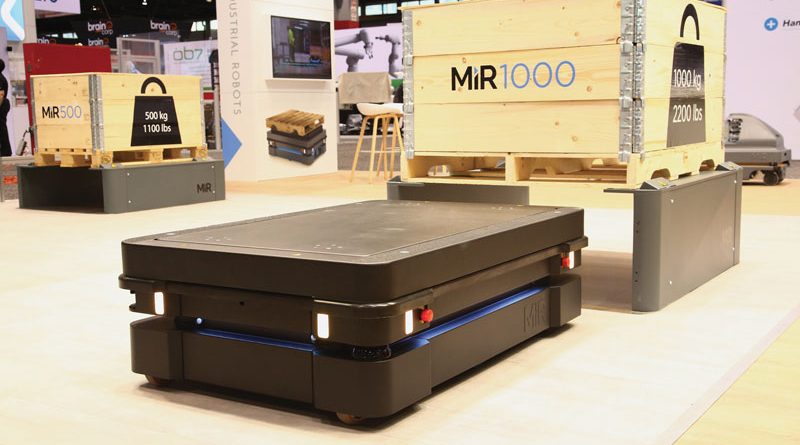Mobile Robots Have Wider Shoulders
Available since April, the MiR1000 is the new MiR mobile robot with 1000 kg payload, doubled compared to the MiR500, launched last year. These models, just like the other ones in the MiR range with lower payload, now rely on artificial intelligence capability for improved navigation and the ability to distinguish between humans, forklifts and other obstacles and react for greater efficiency.
by Sebastiano Mainarda
The fleet of MiR mobile robots is getting bigger. The Danish company, in fact, announced last month the availability of the MiR1000, launched at the Automate 2019 in Chicago and immediately available also in Europe. The new model can automatically pick up, transport and deliver pallets and other heavy loads up to 1000 kg through dynamic environments.
Like the MiR500, introduced in 2018, the MiR1000 is a collaborative, safe and flexible alternative to potentially dangerous and expensive fork lifts on the factory floor. MiR is also releasing another industry first artificial intelligence (AI) capabilities across all of its AMRs for improved navigation.
“Several customers, also in Italy, are planning some possible applications with the new MiR1000”, says Fernando Fandiño Oliver, MiR’s Sales Director Southern Europe. “The new robot is designed to be employed in several industries, in all the environments where the payloads of the previous models were not suitable anymore. Just like the MiR500, the MiR1000 results from the feedbacks over the other models that we could collect by talking to our customers. In fact, our target is to increase our technological know-how in intralogistics”.
Moving heavy components
The MiR1000 joins the manufacturer’s family of user-friendly, powerful and robust AMRs for heavy and light transport that optimize logistics throughout the entire production chain, from the warehouse to the delivery of goods. The MiR100, MiR200 and MiR500 are already installed in more than 45 countries. The MiR1000 was built in response to strong demand from customers who also want to transport heavy materials such as those in the aerospace and automotive industries.
“The market requires smaller and smaller batches”, adds Fernando Fandiño Oliver. “The possibility to rely on a flexible and efficient production is of course a major advantage for manufacturers. MiR mobile robots are thought to make production process simpler. Besides, conventional logistics solutions like forklifts and conveyor belts and even traditional automated guided vehicles (AGVs) haven’t been able to support this type of production”.
The benefits of artificial intelligence
With artificial intelligence (AI) capabilities incorporated into the software and strategically placed cameras that function as an extended set of robot sensors, MiR has enabled its robots for optimized route-planning and driving behaviour. The cameras, called MiR AI Camera, enable the robots to detect and recognize different moving obstacles and react accordingly. For example, the robots will continue driving as usual if they detect a person but will park if they detect an AGV so the AGV can drive by. The robot can also predict blocked areas or highly trafficked areas in advance and reroute instead of entering the blocked area and then re-routing.
The MiR1000 has two flexible pallet lifts for the two most commonly used types of pallets: the EU pallet and the
40” x 48” pallet. Like MiR’s other AMRs, the MiR1000 can be programmed via the intuitive user interface, or through the MiRFleet robot fleet management system, which makes it simple to automate new tasks for a company’s entire fleet of robots. The AMRs can also easily integrate different top modules such as pallet lifts, conveyors, a robot arm or other options to support a wide range of applications.

